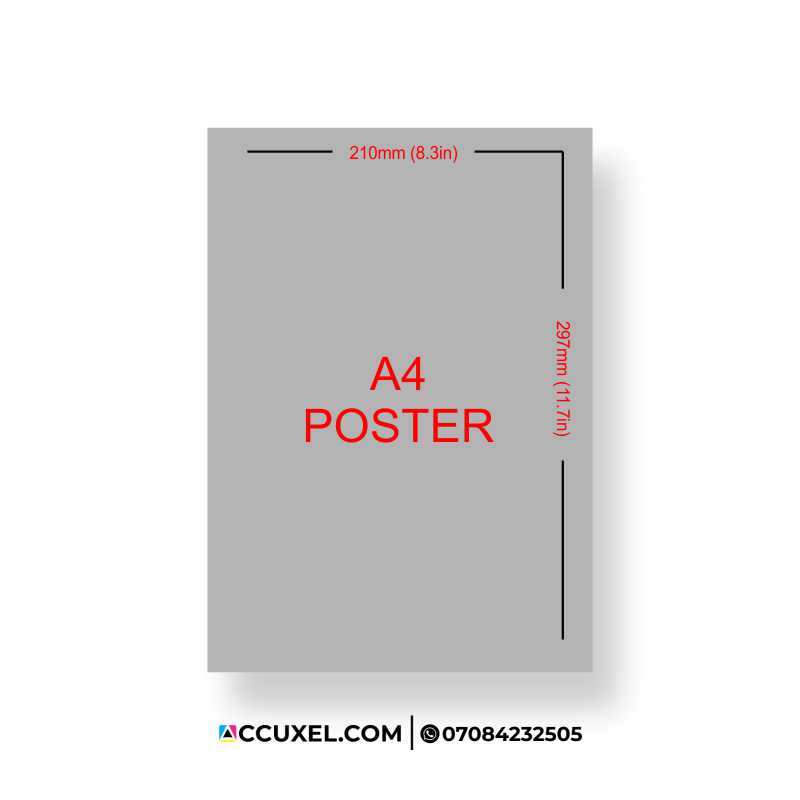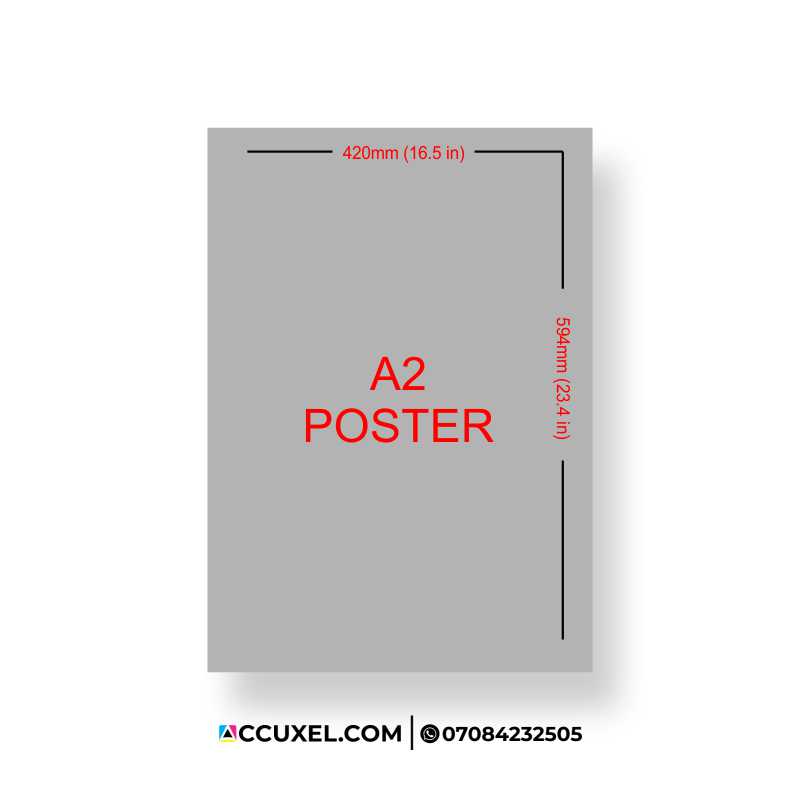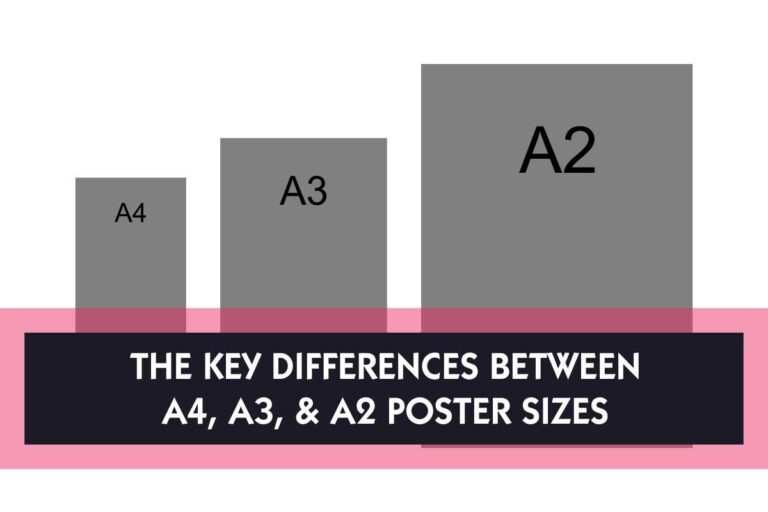Is it for promoting an event, displaying information, or decorating a space? Posters are one of the most common tools used for communication and they come in various sizes, but the most popular are A4, A3, and A2.
Each poster size has its distinct uses and advantages, depending on what you want to achieve with your poster. For someone unfamiliar with these sizes, it can be confusing to decide which one to choose for a project. This guide is here to help clear up the confusion.
So, let’s explore the differences between A4, A3, and A2 posters. We’ll discuss what each size means, where each of them is commonly used, and how to choose the right size for your needs.
Table of Contents
ToggleWhat Does The “A” Size Mean?
Before we dive into the specifics of A4, A3, and A2, let’s quickly cover what “A” sizes are. “A” sizes are part of the ISO 216 standard, which is used worldwide to define paper sizes. The system is based on a rectangle with an aspect ratio of 1: √2 (about 1.41:1).
This means that when you fold a sheet in half, you retain the same proportions. The largest size in the “A” series is A0, and each size down is half the size of the previous one. So, A1 is half the size of A0, A2 is half the size of A1, and so on. If you get the gist *wink*
Understanding A4 Posters

A4 Poster Dimensions
A4 posters measure 210mm by 297mm (or 8.3 inches by 11.7 inches). This is the smallest of the three sizes we’re discussing, and it’s about the size of a standard sheet of printer paper.
Common Uses of A4 Posters
A4 posters are commonly used for personal or smaller-scale advertising, such as flyers, notices, and small announcements. Since they are relatively small, A4 posters are great for places where space is limited, like bulletin boards, store windows, or community boards. They’re easy to produce and distribute, making them cost-effective for businesses and organizations that need to print large quantities of posters.
Advantages of A4 Posters over other poster Sizes
- Affordable and easy to print in bulk.
- Compact size, making them versatile for indoor use.
- Ideal for locations where space is limited.
However, due to their smaller size, A4 posters may not be as attention-grabbing as larger options, especially from a distance. They are best used in spaces where people can get close enough to read them, like on a notice board or a shop window.
Understanding A3 Posters

A3 Poster Dimension
A3 posters measure 297mm by 420mm (or 11.7 inches by 16.5 inches). This size is twice the size of A4, making it noticeably larger.
Want To Print Something?
Common Uses of A3 Posters
A3 posters are popular for medium-sized advertisements or event promotions. They strike a balance between being large enough to grab attention while still being affordable to produce. A3 posters are often used for school projects, classroom displays, medium-scale marketing campaigns, and workplace announcements. They’re also common in stores, cafes, and on walls where you want people to notice them but don’t have enough room for something as large as A2 or A1.
Advantages of A3 Posters
- Bigger than A4 (double the size), offering more visibility and space for information.
- Affordable to print and distribute in medium quantities.
- Versatile for use in offices, schools, and small businesses.
One of the key benefits of A3 posters is their balance between size and practicality. They’re big enough to stand out more than A4 posters because A3 poster is two times the size of A4 poster but not so large that they become difficult or expensive to produce.
Understanding A2 Posters

A2 Poster Dimensions
A2 posters measure 420mm by 594mm (or 16.5 inches by 23.4 inches). This makes them four times the size of an A4 poster.
A2 Posters Common Uses
A2 posters are ideal for larger displays where visibility is important, such as concerts, exhibitions, or product launches. Due to their size, they are more noticeable from a distance, making them a good choice for outdoor advertising, event posters, or promotional materials for shops. A2 posters are also used in art galleries, educational displays, or anywhere that needs a large visual impact.
Advantages of A2 Posters
- Large enough to grab attention from a distance.
- Ideal for outdoor advertising and promotional campaigns.
- More space for images, text, and design elements.
However, because they are larger, A2 posters can be more expensive to print and require more space to display. They are best used in areas where there’s enough room for them to be seen without being overwhelming, such as on large walls or in outdoor locations.
Comparing A4, A3, and A2 Posters: Which Should You Choose?
Now that we’ve covered the specifics of A4, A3, and A2 posters, let’s look at how they compare and how to choose the right one for your needs.
| Aspect | A4 | A3 | A2 |
|---|---|---|---|
| Visibility | Small, best for close-up viewing | Medium size, good for close and medium-distance viewing | Large, ideal for attracting attention from a distance |
| Cost | Most affordable, ideal for mass distribution | More expensive than A4, suitable for medium-scale campaigns | Most expensive, suited for special events or impactful campaigns |
| Content | Limited space, best for minimal text and simple designs | Offers more space for information and images, allows for creative designs | Ample room for large images, detailed info, and eye-catching designs |
| Purpose | Ideal for simple announcements, flyers, or notices | Great for posters seen at a glance without taking up too much space | Best for high-visibility posters for events, promotions, or exhibitions |
Choosing between A4, A3, and A2 posters will ultimately fall back on your specific needs. A4 posters are perfect for small, everyday announcements or notices, while A3 posters offer more space for medium-sized campaigns that require a bit more attention. A2 posters, on the other hand, are best for larger promotions or events that need to stand out and be noticed from afar.
By understanding the strengths and limitations of each poster size, you can ensure that your poster has the right impact, whether it’s hanging on a bulletin board, displayed in a store, or promoting an event. Now that you know the differences between A4, A3, and A2 posters, you’re now ready to choose the size that best fits your project.




